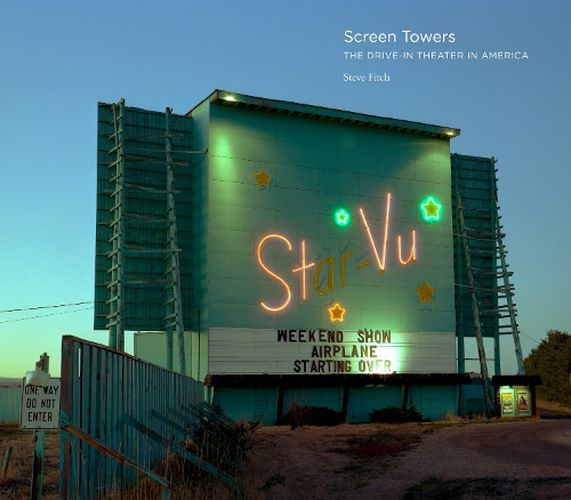Readings Newsletter
Become a Readings Member to make your shopping experience even easier.
Sign in or sign up for free!
You’re not far away from qualifying for FREE standard shipping within Australia
You’ve qualified for FREE standard shipping within Australia
The cart is loading…






Beginning in 1934 and expanding greatly after World War II, mid-century America saw a boom in the construction of large outdoor screen towers on which a projected movie image could be viewed from a parked car. This was the era of the drive-in movie theater, which saw the marriage of the automobile and the Hollywood movie. At its peak during the 1950s and 1960s more than 4,000 drive-in theaters dotted the American landscape. Starting in 1971, Steve Fitch traveled throughout the United States photographing many of these theaters, concentrating on the often stunning neon and painted murals that decorated the back, street-facing side of the tower that supported the white, rectangular screen. These dramatic murals often depicted scenes that related to the local history of the surrounding community and could be seen from many miles away. Working with black-and-white film, he mostly photographed at dusk or night, making striking images that captured the seductive beauty of these roadside monuments. Then, in 1980, Fitch began working in color with a large-format 8" x 10" view camera. Interested in the collecting and comparing possibilities of photography, he began to shift his emphasis to making pictures of the actual white screen itself and the inside spaces of the theater. By the early 1980s, many of the drive-ins were being abandoned or even torn down. The era of the drive-in theater was nearing its end, although today there are still about 300 operating drive-ins in America keeping alive the thrill of watching a movie outdoors, under the stars. AUTHOR: Steve Fitch has been a photographer since the late 1960s and has taught at the University of Colorado at Boulder, Princeton University, and, most recently, the College of Santa Fe and Santa Fe University of Art and Design. He is the recipient of two National Endowment for the Arts Fellowships (1973 and 1975) and the last National Endowment for the Arts Survey Grant, awarded in 1981. He also received the Eliot Porter Fellowship in 1999. He is the author of Diesels and Dinosaurs: Photographs from the American Highway (Long Run Press, 1976), Gone: Photographs of Abandonment on the High Plains, with essays by Merril Gilfillan, Kathleen Howe, and Evelyn Schlatter (University of New Mexico Press, 2002), and Vanishing Vernacular: Western Landmarks (George F. Thompson Publishing, 2018). His work is in the collections of the Smithsonian American Art Museum, Whitney Museum of American Art, and Yale University, among many others. His Website is stevefitch.com. 42 colour, 34 b/w photographs
$9.00 standard shipping within Australia
FREE standard shipping within Australia for orders over $100.00
Express & International shipping calculated at checkout
Beginning in 1934 and expanding greatly after World War II, mid-century America saw a boom in the construction of large outdoor screen towers on which a projected movie image could be viewed from a parked car. This was the era of the drive-in movie theater, which saw the marriage of the automobile and the Hollywood movie. At its peak during the 1950s and 1960s more than 4,000 drive-in theaters dotted the American landscape. Starting in 1971, Steve Fitch traveled throughout the United States photographing many of these theaters, concentrating on the often stunning neon and painted murals that decorated the back, street-facing side of the tower that supported the white, rectangular screen. These dramatic murals often depicted scenes that related to the local history of the surrounding community and could be seen from many miles away. Working with black-and-white film, he mostly photographed at dusk or night, making striking images that captured the seductive beauty of these roadside monuments. Then, in 1980, Fitch began working in color with a large-format 8" x 10" view camera. Interested in the collecting and comparing possibilities of photography, he began to shift his emphasis to making pictures of the actual white screen itself and the inside spaces of the theater. By the early 1980s, many of the drive-ins were being abandoned or even torn down. The era of the drive-in theater was nearing its end, although today there are still about 300 operating drive-ins in America keeping alive the thrill of watching a movie outdoors, under the stars. AUTHOR: Steve Fitch has been a photographer since the late 1960s and has taught at the University of Colorado at Boulder, Princeton University, and, most recently, the College of Santa Fe and Santa Fe University of Art and Design. He is the recipient of two National Endowment for the Arts Fellowships (1973 and 1975) and the last National Endowment for the Arts Survey Grant, awarded in 1981. He also received the Eliot Porter Fellowship in 1999. He is the author of Diesels and Dinosaurs: Photographs from the American Highway (Long Run Press, 1976), Gone: Photographs of Abandonment on the High Plains, with essays by Merril Gilfillan, Kathleen Howe, and Evelyn Schlatter (University of New Mexico Press, 2002), and Vanishing Vernacular: Western Landmarks (George F. Thompson Publishing, 2018). His work is in the collections of the Smithsonian American Art Museum, Whitney Museum of American Art, and Yale University, among many others. His Website is stevefitch.com. 42 colour, 34 b/w photographs